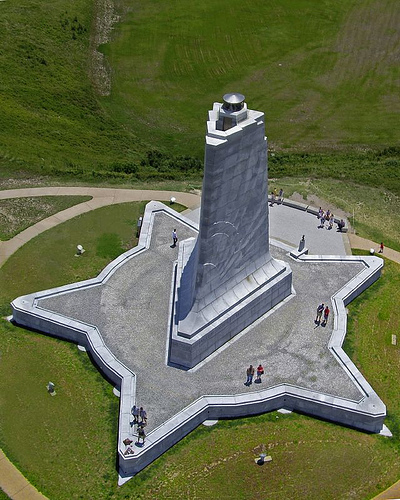
Outpost History
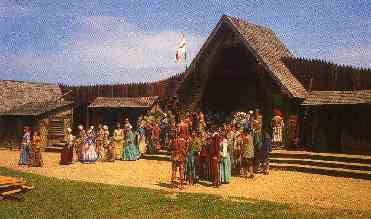
| Route 66 | Cities | Beaches |
 |
Outpost History |
 |
|
| The Cape Hatteras Lighthouse is a mandatory visit. There are people who come all the way across on the ferry just to climb the lighthouse and visit the museum, then go back to the mainland. It is the greatest lighthouse in North America. Its black and white spiral with the red brick base has become an icon for all lighthouses, for the Outer Banks, for North Carolina, and for many private businesses. To help maintain this magnificent tower, a fee of $6 is charged to climb it. On summer weekends, the line can be long, so you should try to go early in the day or during the week. The climb takes you up a very long flight of steel steps which spiral around inside the brick structure. It takes about five minutes to reach the top, where you emerge onto a circular platform just below the rotating beacon. The view is spectacular. You can see out across the island, Pamlico Sound to the northwest, the beaches below you, the Cape to the South and Buxton to the north. You should take a pair of binoculars and a camera. The picture at right was taken from the Burris airplane flight. The road off Route 12. | 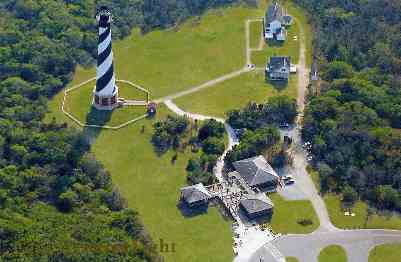 |
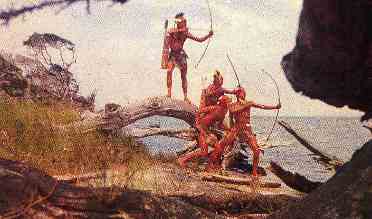 |
"The Lost Colony" is America's oldest continuously running outdoor drama. It is located just north of Manteo on Roanoke Island. The three hour play tells the story of the Elizabethan colony which was England's first attempt to settle the New World. The amphitheatre just on the edge of the bay is beautiful, as are the grounds around it. This is a very sophisticated production. Many famous actors and actresses began their careers here. The local favorite is Andy Griffith. Two hours before each performance, a guided tour of the backstage is offered. You see the costuming, sets, and other support operations and get to ask questions along the way. You might take bug spray and a light jacket, because even in the hottest stretch of Summer, a cool breeze blows in off the water after sundown. The picture top right shows the main stage. Shown here is a promontory off stage left. |
| Chickamacomico is the best remaining example of the string of lifesaving stations which served the coastline and eventually evolved into today's Coast Guard. Just off Highway 12 in Rodanthe, on the right heading North, the station includes the boathouse, cookhouse, maintenance and repair shop, and an older station which is now a museum. There are guided tours and special programs and demonstrations. The lifesaving stations on Hatteras guarded the most dangerous water on the Atlantic Coast, and the men of this station pulled many survivors to shore. The shop sells nautical gifts, books, and handmade decoys and other local items. This station operated until 1954. How these men went out in the middle of January nights and pulled people from sinking ships or the dark water without drowning themselves is incredible. They received decorations for their work, and they were definitely heroes. Sometimes launching the wooden rowboats into the stormy surf was a challenge, before they even got out to the sinking ships. | 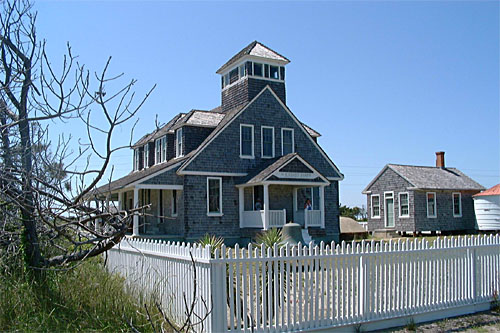 |
 |
The Native American Museum in Frisco is a mandatory stop. Joyce and Carl Bornfriend have devoted their lives to accumulating this collection. It doesn't beat the huge American Indian Museum in Washington DC, but with the closing of the Native American Center in Niagara Falls it may be the second best collection anywhere. The 100 year old building is not impressive, and there's not much advertising. You can drive right by without even noticing unless you pay attention. But inside and out back are priceless artifacts, exhibits, and displays ranging from cradles to walking sticks to baskets (left). They have the definitive collection of Hatterask objects from the tribe which inhabited this island when the English built The Lost Colony. The dugout canoe was found right on this property. East Carolina University's archeaological dig on Hatteras Island unearthed many of these items. There's an impressive gift shop and antique shop. If you bring a group, call ahead and schedule a guided tour and possibly a workshop or seminar. Mainland tribes from across the nation are represented. |
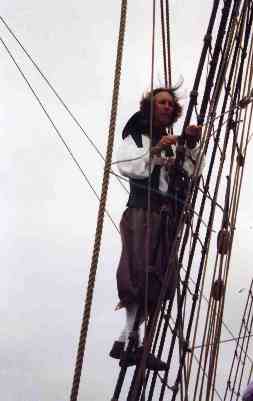 |
The Queen Elizabeth is a reconstructed version of the 1600 ship that brought the Lost Colony settlers to Roanoke Island. Anchored just off the reconstructed colony, the ship has costumed interpreters (left) on board to answer questions. In the visitor center is a 30 minute film which gives you the historical background. It's a big ship and the trees do not allow you to back up far enough to frame a good photo. This photo is taken from the Manteo waterfront walkway across the bay with a telephoto lens. If you have a Scout or school group with a particular interest in the Jamestown - Roanoke era, a letter several months in advance might let you time your visit to coincide with one of the sailing trips out across the Sound. Even if that's not possible, you could request special opportunities such as rigging the sails or climbing up to the crow's nests. | 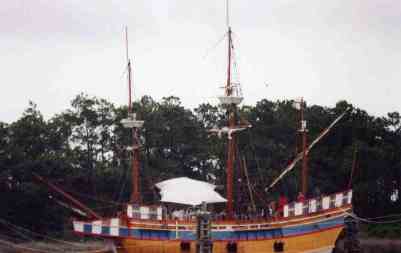 |
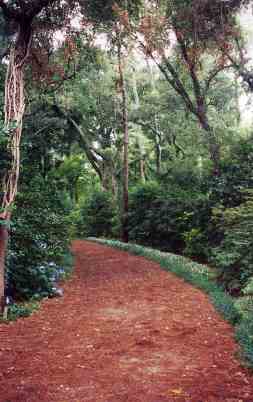 |
The Elizabethan Gardens is a magnificent floral display, with pathways winding through huge trees, flowering bushes, sculpture and fountains. A model of a classic Elizabethan garden back in England, this is one of the best horticultural exhibits in America. It takes about 90 minutes to see everything. The Gardens are just up the road from the Lost Colony. There is an excellent gift shop. Bring your camera. This would probably not interest a grade school or middle school group, unless they were studying botany, but by high school students should be able to appreciate it. It's a photographer's fantasyland, with patches of deep shade alternating with narrow rays of sunshine or open areas, all highlighted by brilliant flowers in all colors. There are benches along the way and at the back the path leads to views of the bay. | 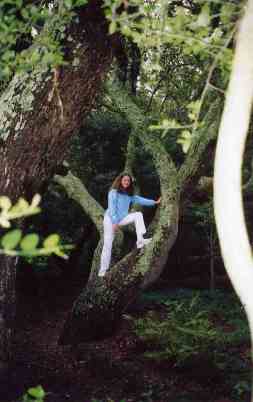 |
| Portsmouth requires a whole afternoon, but is worth the visit. You drive to Ocracoke and take a ferry across the inlet to Portsmouth Island, a 40 mile long stretch of sand which offers some of the best shelling on the Outer Banks. Portsmouth Village was the largest and busiest port in North Carolina in the 1700s and 1800s. Then the currents shifted, the ocean rose, and the harbor filled in. Portsmouth was left stranded. The people drifted away and today the village is abandoned, maintained only by the National Park Service. All the homes, church, and other buildings are in good shape but visiting a ghost town is an eerie experience. The normal ferry shuttle only gives you about 90 minutes, but by special arrangement they can come back later. You might do that and spend two hours down at the beach. It's a beautiful beach with warm water and great surf. A few groups a year backpack the island. Figure on four days and arrange for the ferry to pick you up at the other end. If you have a good fisherman, bring equipment and eat fresh fish the whole trip. Bring bug spray and suntan lotion. | 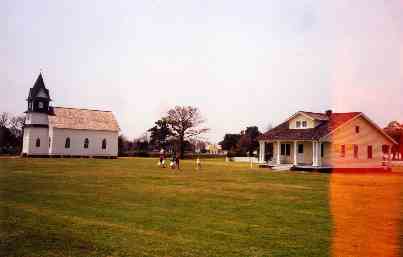 |
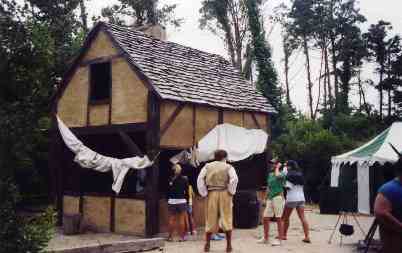 |
Roanoke, The Historic "Lost Colony." The site of the first English colony in the New World, some of it original and some of it carefully reconstructed under the close supervision of historians and archeologists. The visitor center offers a 30 minute film, museum and presentations. A visit here and to the ship The Elizabeth is a good prelude to the evening performance of The Lost Colony. There are programs here for Scouts, students and kids in general. Stopping here and then Jamestown on the way home is an excellent introduction to the American Colonial Period. | 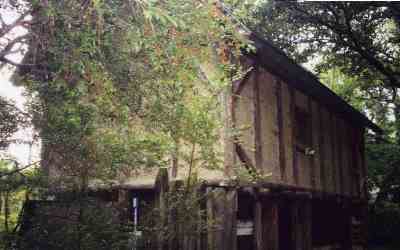 |
| The Graveyard of the Atlantic Museum is next to the ferry terminal in Hatteras Village. The building itself is an architectural masterpiece, a shiplike structure with portholes and curved beams. The main theme is the ships of the Outer Banks, including the people who sailed them, the adventures they had in the nearby waters, and the shipwrecks some of them suffered. The main focus is on 1524-1945. Displays include the famous pirates who used the islands as hiding places between raids and buried their treasures in the sands here, the German submarines which lurked along the shores during World War II and sent English speaking crew members into shore in rowboats to buy groceries, the famous Billy Mitchell demonstration bombing raid, Coast Guard rescue operations, and the fishing fleet both sport and commercial. There's a gift shop, and commemorative plaques outside. | 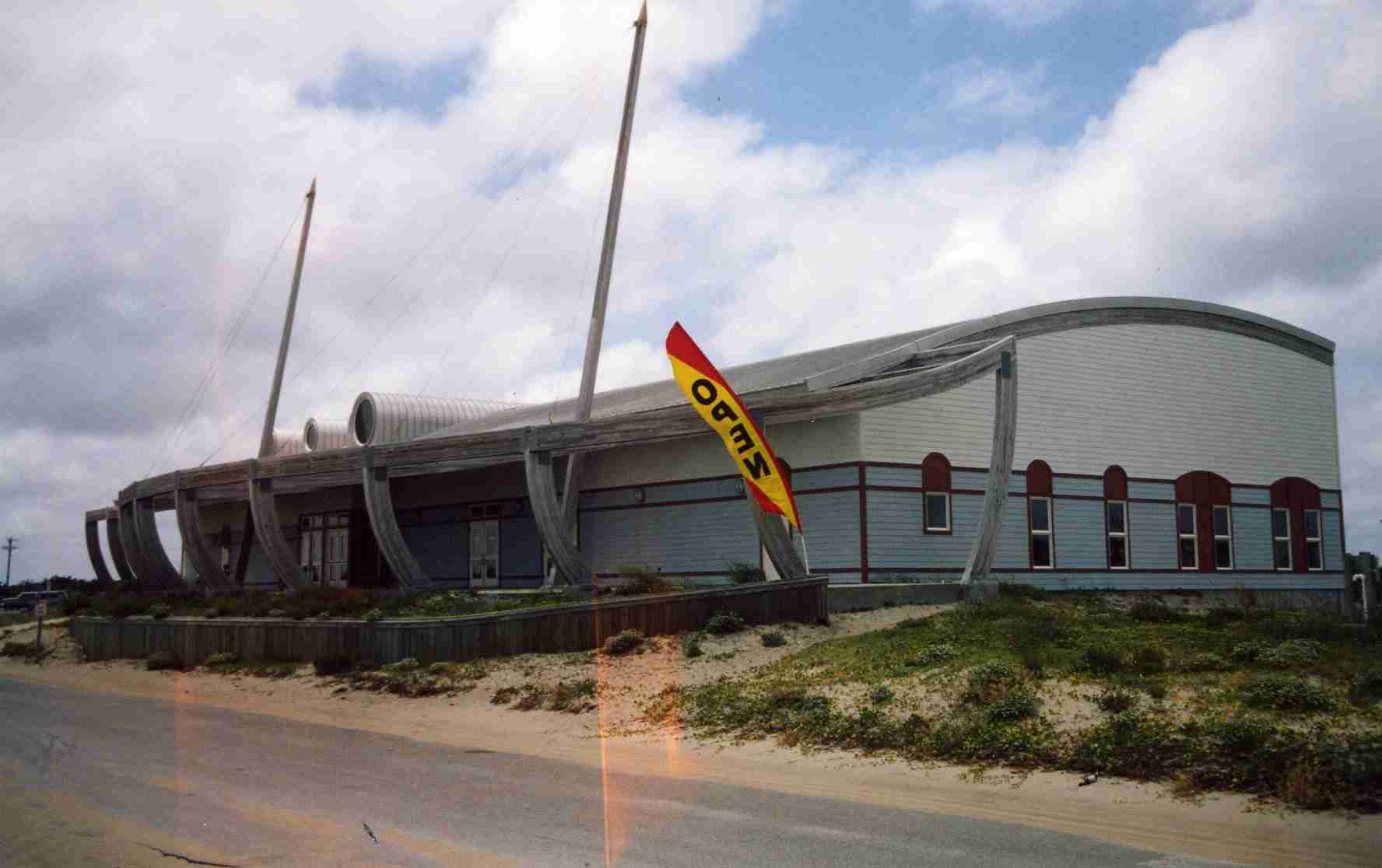 |
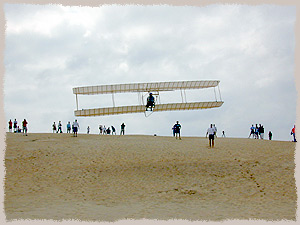 |
The Wright Brothers Memorial is one of the more incredible stops on a Hatteras trip. It's hard to believe flight actually began here, that Orville and Wilbur Wright left their bicycle shop in Dayton, Ohio, and camped out down here every Fall to experiment with building and flying the first airplane. The photo top left was taken from one of the airplane flights (see Miscellany). It shows the hilltop monument from which they took off. Here at left is a reenactment of the flight down along the dunes. This is a replica. The original biplane sits in a magnificent hangar sized visitor center. There are many special programs offered by the National Park Service. Some of them relate to various Boy Scout merit badges. For nonScouts, there is a Junior Ranger Program. We have spent one entire day here and not done everything, but you can hit the highlights in about two hours. Even grade school kids come away from here awed by how two bicycle mechanics pursuing a dream changed the history of the world. As soon as you arrive on Hatteras, call and see what special programs may be available while you're here, and try to arrange your visit to include one of those days. We've hit the kite flying, hot air ballooning, and model plane racing days several times and our groups always love it. 252-986-2996. |
|
|||
|